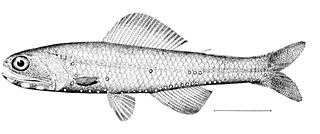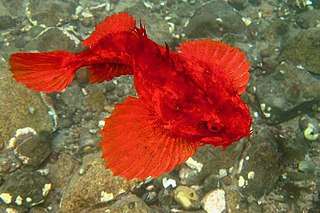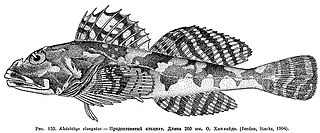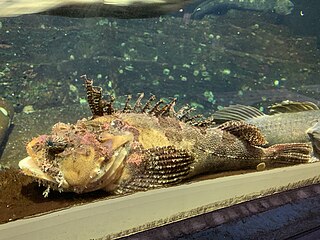
Brackish water, sometimes termed brack water, is water occurring in a natural environment that has more salinity than freshwater, but not as much as seawater. It may result from mixing seawater and fresh water together, as in estuaries, or it may occur in brackish fossil aquifers. The word comes from the Middle Dutch root brak. Certain human activities can produce brackish water, in particular civil engineering projects such as dikes and the flooding of coastal marshland to produce brackish water pools for freshwater prawn farming. Brackish water is also the primary waste product of the salinity gradient power process. Because brackish water is hostile to the growth of most terrestrial plant species, without appropriate management it is damaging to the environment.

The largemouth bass is a carnivorous freshwater gamefish in the Centrarchidae (sunfish) family, a species of black bass native to the eastern and central United States, southeastern Canada and northern Mexico, but widely introduced elsewhere. It is known by a variety of regional names, such as the widemouth bass, bigmouth bass, black bass, bucketmouth, largies, Potter's fish, Florida bass, Florida largemouth, green bass, bucketmouth bass, Green trout, gilsdorf bass, Oswego bass, LMB, and southern largemouth and northern largemouth. The largemouth bass is the state fish of Georgia and Mississippi, and the state freshwater fish of Florida and Alabama.

The Hemitripterinae is a subfamily of the scorpaeniform family Agonidae, known as sea ravens or sailfin sculpins. They are bottom-dwelling fish that feed on small invertebrates, found in the northwest Atlantic and north Pacific Oceans. They are covered in small spines.

The cabezon is a large species of sculpin native to the Pacific coast of North America. Although the genus name translates literally as "scorpion fish", true scorpionfish belong to the related family Scorpaenidae. The cabezon is the only known member of its genus.

Protomyctophum is a genus of lanternfishes.

Gymnoscopelus is a genus of lanternfishes. The name is from the Greek gymnos, "naked" and skopelos, "lanternfish."
H. americanus may refer to:

Jaton hemitripterus is a species of sea snail, a marine gastropod mollusk in the family Muricidae, the murex snails or rock snails.
Jaton is a genus of sea snails, marine gastropod mollusks in the subfamily Ocenebrinae of the family Muricidae, the murex snails or rock snails.

Notoscopelus is a genus of lanternfishes.

Blepsias is a genus of marine ray-finned fishes belonging to the family Agonidae, the poachers and related fishes. These fishes are found in the coastal northern Pacific Ocean from Japan to California.

Hemitripterus is a genus of marine ray-finned fishes, sculpins, belonging to the subfamily Hemitripterinae which is part of the family Agonidae. These fishes are found in the North Pacific and Northwest Atlantic Oceans.

Hemitripterus americanus, the sea raven, is a species of marine ray-finned fish belonging to the subfamily Hemitripterinae of the family Agonidae. The sea raven is found along the Atlantic coast of North America.

Alcichthys elongatus is a fish in the family Cottidae (sculpins), and the only valid member of its genus. It was described by Franz Steindachner in 1881. It is a marine, boreal fish which is known from the northwestern Pacific Ocean, including the Sea of Okhotsk and Japan. It dwells at a depth range of 15 to 269 m, and inhabits rocky reefs. Males can reach a maximum total length of 44 cm (17 in), but more commonly reach a TL of 31.5 cm (12.4 in). The maximum recorded weight is 1 kg (2.2 lb).
Aphyonus is a genus of blind cusk eels from the family Aphyonidae. It contains four species. A sampling of specimens of Aphyonus showed that the type species of Aphyonus, A. gelatinosus, was not closely related to the other known species in the genus, and a new genus Paraphyonus was named for these, including two newly identified species. The result of this classification is that Aphyonus would be a monotypic genus.
Notoscopelus bolini is a species of lanternfish in the family Myctophidae. It is found in the North Atlantic Ocean and the Mediterranean Sea. It was first described in 1975 by the American ichthyologist Basil Nafpaktitis and named in honour of the American marine biologist Rolf Ling Bolin who had reviewed the genus in 1959.
Zaniolepis frenata, the shortspine combfish, is a species of ray-finned fish belonging to the family Zaniolepididae.The species occurs in the eastern Pacific Ocean.

Hemitripterus villosus, the sea raven, is a species of marine ray-finned fish belonging to the subfamily Hemitripterinae of the family Agonidae. The sea raven is found in the northwestern Pacific Ocean off the coast of Russia and Japan.













